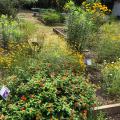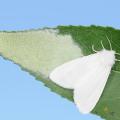Bagworms
Bagworms are the most common insect pests of juniper, arborvitae, cedars, and other needle-bearing evergreens. They also occasionally attack broadleaf trees and shrubs like river birch and Indian hawthorn. Infested trees are made unsightly by defoliation and the presence of the bags. Heavy infestations can cause total defoliation, making it necessary to replace the affected plant. The caterpillars live inside silken bags which they cover with pieces of foliage from their host plant. The caterpillars also pupate inside these bags and adult females never leave the bags. They simply mate with the winged males, deposit their eggs inside the bags, and die. Bagworms overwinter inside these bags as eggs, which hatch the following spring. Because there is only one generation per year, proper spray timing is the key to good control.
Control Bagworms: Removing the bags by hand is a good control option for small trees with light infestations, but you may need to use scissors or hand pruners to cut the strong silk fibers that attach the bags to the tree. For heavy infestations or large plants, spray with an insecticide containing spinosad (Fertilome, Bonide, and Monterey companies all sell spinosad products). For best control, apply sprays shortly after eggs have hatched in the spring and before caterpillars have grown large enough to cause significant damage. This is about the time crape myrtles have finished leafing out. Bagworms do not normally occur on crape myrtles, but bagworm egg-hatch coincides with spring leaf development of crape myrtles. Avoid spraying with products like carbaryl, malathion, acephate, or pyrethroid insecticides (permethrin, cyfluthrin, bifenthrin, etc.). These products will kill bagworms, but they are also prone to trigger spider mite outbreaks, and there are no good treatment options for home gardeners to use against spider mites.
See Insect Pests of ornamental plants in the home landscape, page 22 and pages 39-41 for more information on bagworms.
Publications
News
A grant from Coast Electric will allow for a renovation of the Mississippi State University Crosby Arboretum’s pollinator garden. Pat Drackett, director of the arboretum, said the pollinator garden was established in 2001 as the Explorers’ Garden. It is a 3,000-square-foot space with a variety of native and other plants that helps teach visitors how to create havens for pollinators.
The 2020 Fall Flower & Garden Fest will be a virtual, educational event this year.
A tent for camping in the woods can be a good thing, but a tent filled with caterpillars in a pecan tree can be bad news for homeowners.



